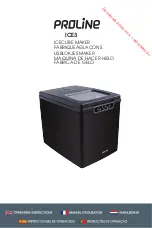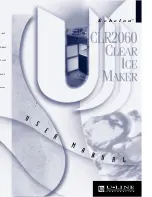
P18AL Service Manual
SERVICE OPERATIONS
3/6/07
9-5
Removal of Ammonia Refrigerant from the Machine.
Liquid ammonia can be removed from the
machine through the receiver drain valve. Refer to Sections 1, 2 and Appendix A for special
warnings and instructions regarding the handling of ammonia. Make sure you are familiar with and
technically qualified to handle anhydrous-ammonia refrigerant.
! WARNING !
Approved recovery equipment, hoses, gages, and refrigerant containers must be
used to comply with all local and federal EPA regulations.
! WARNING !
! WARNING !
Follow these instructions carefully.
Severe personal injury can result from improper
discharge of refrigerant.
! WARNING !
! WARNING !
It is not recommended that refrigerant be transferred from a
refrigeration system into a cylinder. If such a transfer is made,
the refrigerant cylinder must be an approved CLEAN cylinder--
free of any contaminants or foreign materials--and must be
weighed continuously to assure contents do not exceed net weight
specified by cylinder manufacturer or any applicable
code requirements.
! WARNING !
If ammonia vapor is released from the machine, it may be purged into water, which will absorb it.
Follow the purging instructions. See “Purging Non-condensables”.
Refrigerant Leaks.
Anhydrous ammonia leaks can be detected by odor, sulfur stick, soap solution,
or test paper. The odor is normally noticed first and the location of the leak is found with soap or
sulfur stick. Soap solution can be purchased from your refrigeration supply house or it can be made
by mixing four parts water, one part liquid soap, and a few drops of Glycerin for better capillary
attraction.
•
Apply soap solutions with a narrow brush or spray bottle to all joints, welds, or areas of
suspicion. The solution will form bubbles if there is a leak.
•
Light the end of the sulfur stick and pass it around suspected points of leakage. A white cloud
will form where a leak is, even if it is very small.
•
Moisten a strip of test paper and pass it around the suspected area. If the paper comes in contact
with ammonia, it will turn red. Coils submerged in water, or condenser cooling water may be
tested by dipping a strip directly in the water. If ammonia is present, the paper will turn red.
Always remove refrigerant pressure from the vessel, tubing, or component part before repairs are
attempted.
Note: Sulfur sticks and test paper can be obtained from your ammonia supplier.
Summary of Contents for P18AL TUBE-ICE
Page 1: ...8 28 00 P18AL TUBE ICE MACHINE Manual Part Number 12A4171M09 Service Manual 5000 ...
Page 4: ......
Page 14: ...P18AL Service Manual INTRODUCTION 3 6 07 1 4 FIGURE 1 1 P18AL Front View ...
Page 15: ...P18AL Service Manual INTRODUCTION 3 6 07 1 5 FIGURE 1 2 P18AL Back View ...
Page 16: ...P18AL Service Manual INTRODUCTION 3 6 07 1 6 FIGURE 1 3 P18AL Left View ...
Page 17: ...P18AL Service Manual INTRODUCTION 3 6 07 1 7 FIGURE 1 4 P18AL Right View ...
Page 18: ...P18AL Service Manual INTRODUCTION 3 6 07 1 8 ...
Page 48: ...P18AL Service Manual ELECTRICAL CONTROLS 3 6 07 6 6 ...
Page 56: ...P18AL Service Manual MAINTENANCE 3 6 07 7 8 ...
Page 64: ...P18AL Service Manual TROUBLESHOOTING 3 6 07 8 8 ...
Page 76: ...P18AL Service Manual SERVICE OPERATIONS 3 6 07 9 12 FIGURE 9 3 Cutter Water Tank Assembly ...
Page 78: ...P18AL Service Manual TABLES CHARTS 3 6 07 10 1 10 Tables Charts ...
















































